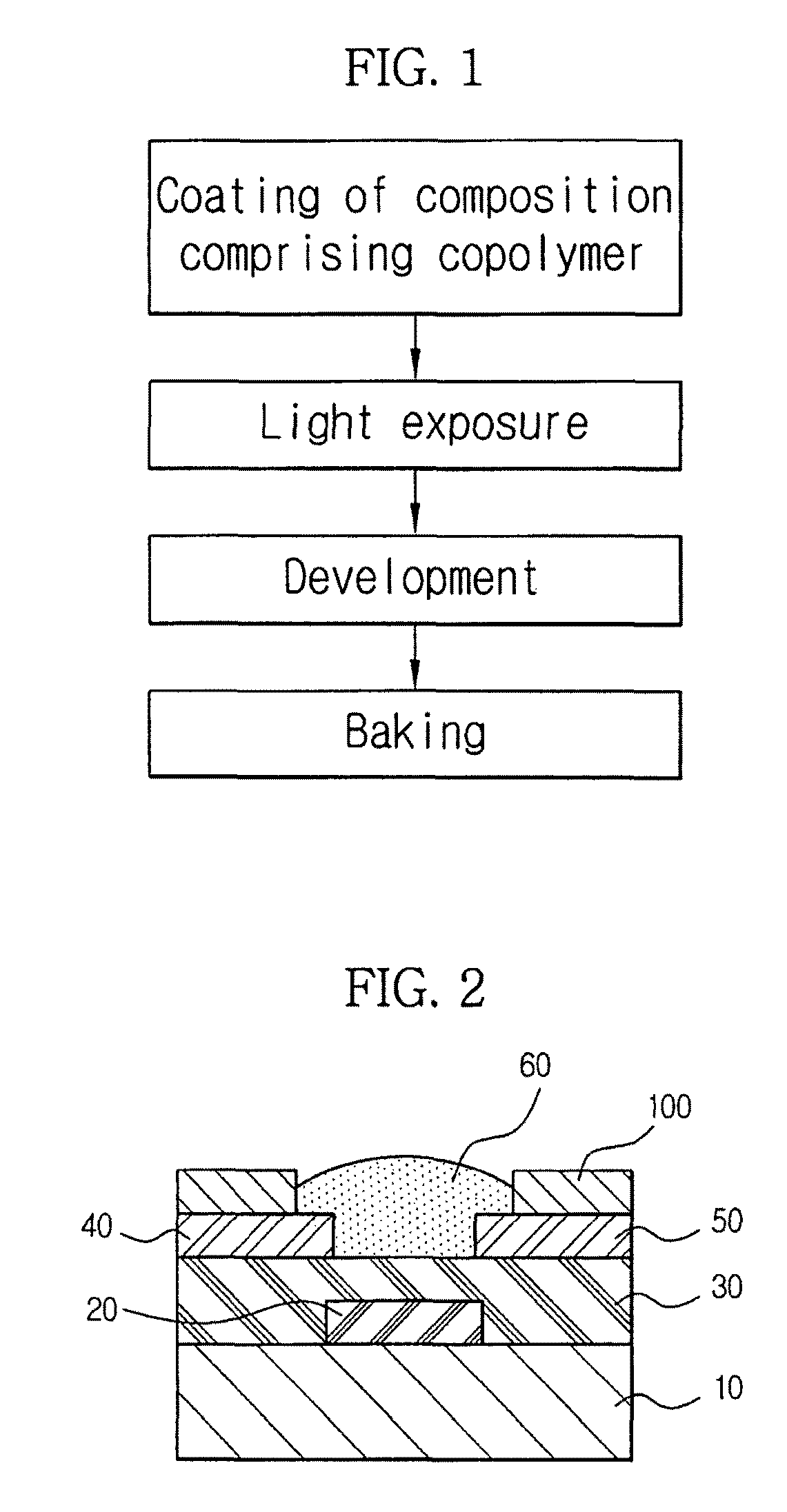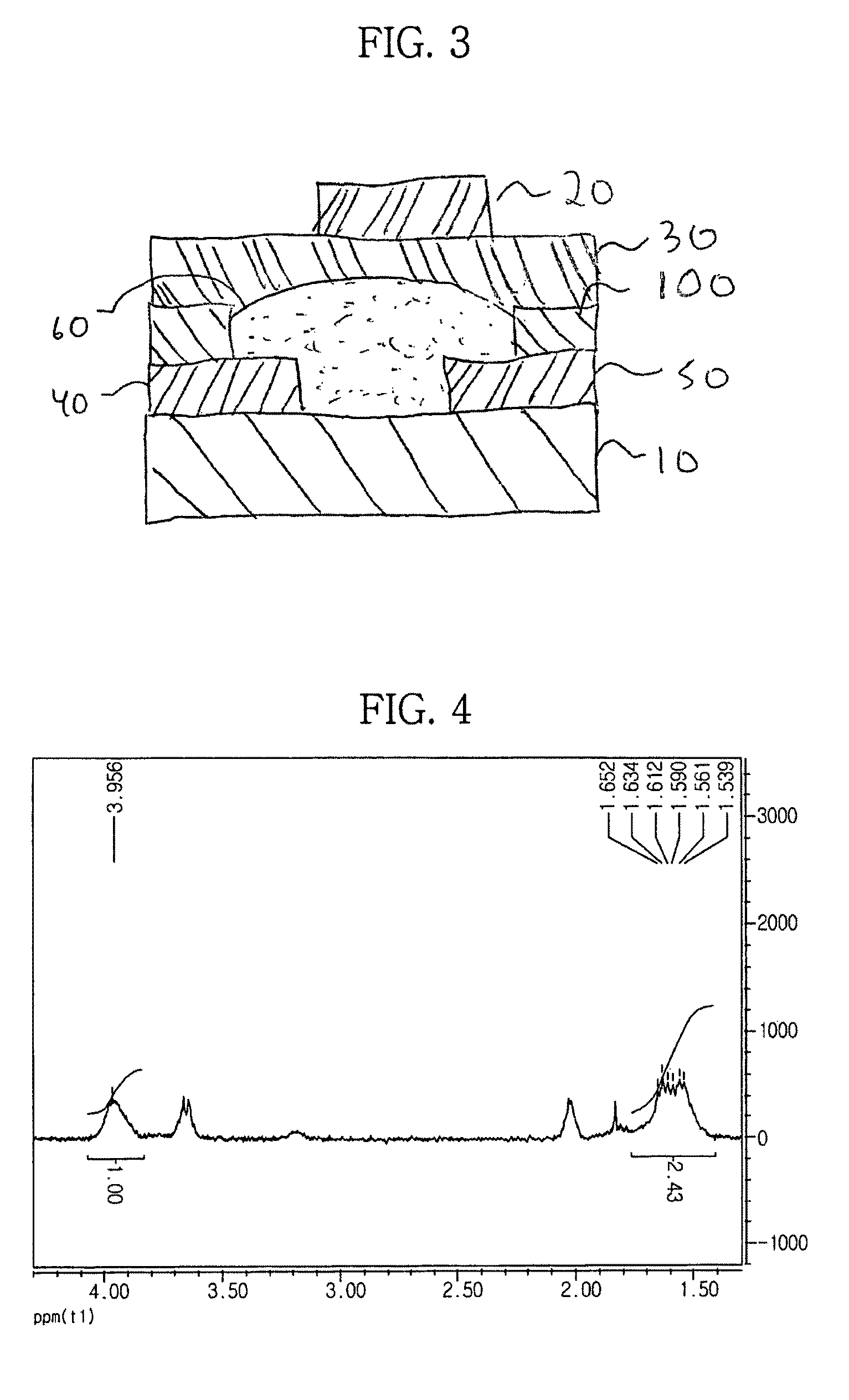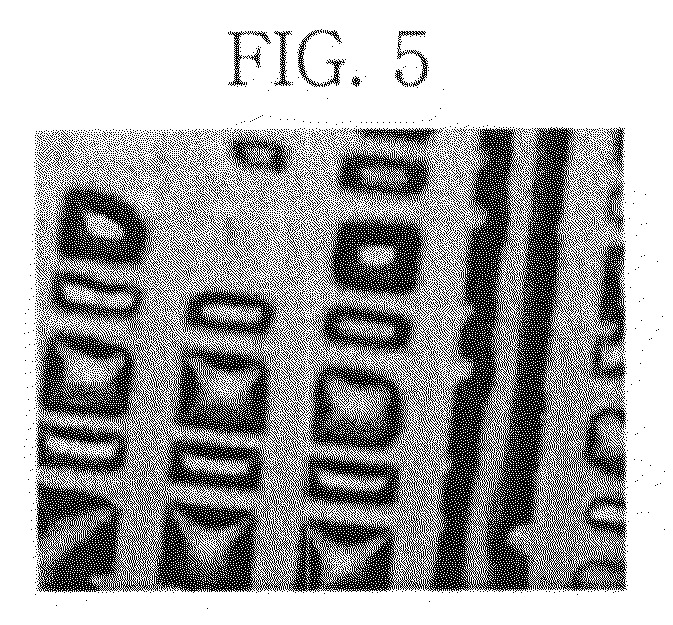Perfluoropolyether copolymer composition for forming banks
a technology of perfluoropolyether and composition, applied in the direction of thermoelectric device junction materials, electrical apparatus, solid-state devices, etc., can solve the problems of deterioration of the performance of the organic thin film transistor, degradation of the characteristics of the device, and degradation of the characteristics of the adjacent organic electronic device, so as to prevent or reduce the degradation of the organic film and increase the definition of the ink material
- Summary
- Abstract
- Description
- Claims
- Application Information
AI Technical Summary
Benefits of technology
Problems solved by technology
Method used
Image
Examples
synthesis example 1
Synthesis of Copolymers
[0095]As depicted in Reaction 1, PFPE-Si(OEt)3 of Formula 3 was mixed with polyvinyl alcohol (#2000, Kanto Chemical Co.) as a photosensitive polymer in accordance with the compositions shown in Table 1. The mixtures were stirred and extracted with a fluorinated organic solvent (Vertrel XF®, DuPont). The obtained extracts were washed to give copolymers. The structure of the copolymers was identified by 1H-NMR spectroscopy. FIG. 4 shows the 1H-NMR spectrum of the copolymer in which the ratio of molar equivalents of the PFPE-Si(OEt)3 to the molar equivalents of the photosensitive polymer was about 0.05:1. The ratio of the number of hydrogen atoms contained in the hydroxyl groups to the number of secondary hydrogen atoms contained in the aliphatic chain was about 1:2.04 in pure polyvinyl alcohol, while the ratio was about 1:2.43 in the copolymer, which is apparent from the spectrum of FIG. 4. These results indicate that some hydroxyl groups of the polyvinyl alcoho...
example 1
[0097]A glass substrate was cleaned, and aluminum (Al) was deposited thereon by a sputtering technique to form a gate electrode having a thickness of about 1,500 Å. An organic gate insulating film was formed to a thickness of about 4,000 Å on the gate electrode and the glass substrate by spin coating at about 2,000 rpm, followed by sequential baking at about 70° C. for about 20 minutes and about 200° C. for about 2 hours. Au was deposited on the gate insulating film to a thickness of about 700 Å by a thermal evaporation method, and was then subjected to a photolithographic process to form an Au electrode pattern. The deposition was conducted under a vacuum pressure of about 2×10−7 torr and a deposition rate of about 5 Å / sec.
[0098]Subsequently, banks were formed on the Au electrodes in accordance with the following procedure. Ammonium dichromate (Sigma Aldrich) was added to an about 5 wt % solution of each of the PFPE-polyvinyl alcohol copolymers in deionized water to prepare a coati...
experimental example 1
[0102]To evaluate the patternability of banks formed by the method of example embodiments, the size of the banks formed in Example 1 was measured using a confocal laser scanning microscope (OLYMPUS LEXT OLS3000). The results are shown in FIG. 5.
[0103]As apparent from the foregoing, the composition for forming banks according to example embodiments may include a copolymer of a perfluoropolyether derivative as a fluorinated surface modifier and a photosensitive polymer. Because the copolymer serves to minimize or reduce the surface energy of the composition, an ink material to be filled between banks may exhibit increased definition for the banks despite a decreased surface contact angle of an organic solvent of the ink material.
[0104]The use of a water-soluble photosensitive polymer, not having an influence on an organic insulating film, may enable the prevention or reduction of deterioration in the performance of an organic thin film transistor.
[0105]Where a simple mixture of a wate...
PUM
| Property | Measurement | Unit |
|---|---|---|
| wavelength | aaaaa | aaaaa |
| power | aaaaa | aaaaa |
| pressure | aaaaa | aaaaa |
Abstract
Description
Claims
Application Information
 Login to View More
Login to View More - R&D
- Intellectual Property
- Life Sciences
- Materials
- Tech Scout
- Unparalleled Data Quality
- Higher Quality Content
- 60% Fewer Hallucinations
Browse by: Latest US Patents, China's latest patents, Technical Efficacy Thesaurus, Application Domain, Technology Topic, Popular Technical Reports.
© 2025 PatSnap. All rights reserved.Legal|Privacy policy|Modern Slavery Act Transparency Statement|Sitemap|About US| Contact US: help@patsnap.com



